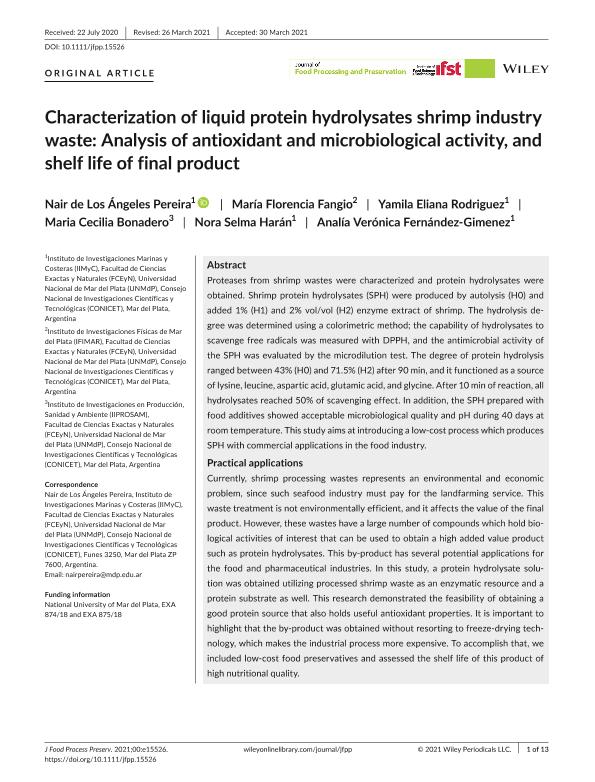Mostrar el registro sencillo del ítem
dc.contributor.author
Pereira, Nair de Los Angeles

dc.contributor.author
Fangio, Maria Florencia

dc.contributor.author
Rodriguez, Yamila Eliana

dc.contributor.author
Bonadero, María Cecilia

dc.contributor.author
Haran, Nora Selma

dc.contributor.author
Fernandez Gimenez, Analia Veronica

dc.date.available
2022-09-27T11:02:11Z
dc.date.issued
2022-08
dc.identifier.citation
Pereira, Nair de Los Angeles; Fangio, Maria Florencia; Rodriguez, Yamila Eliana; Bonadero, María Cecilia; Haran, Nora Selma; et al.; Characterization of liquid protein hydrolysates shrimp industry waste: Analysis of antioxidant and microbiological activity, and shelf life of final product; Wiley Blackwell Publishing, Inc; Journal of Food Processing and Preservation; 46; 8; 8-2022; 1-13
dc.identifier.issn
0145-8892
dc.identifier.uri
http://hdl.handle.net/11336/170550
dc.description.abstract
Proteases from shrimp wastes were characterized and protein hydrolysates were obtained. Shrimp protein hydrolysates (SPH) were produced by autolysis (H0) and added 1% (H1) and 2% vol/vol (H2) enzyme extract of shrimp. The hydrolysis degree was determined using a colorimetric method; the capability of hydrolysates to scavenge free radicals was measured with DPPH, and the antimicrobial activity of the SPH was evaluated by the microdilution test. The degree of protein hydrolysis ranged between 43% (H0) and 71.5% (H2) after 90 min, and it functioned as a source of lysine, leucine, aspartic acid, glutamic acid, and glycine. After 10 min of reaction, all hydrolysates reached 50% of scavenging effect. In addition, the SPH prepared with food additives showed acceptable microbiological quality and pH during 40 days at room temperature. This study aims at introducing a low-cost process which produces SPH with commercial applications in the food industry. Practical applications: Currently, shrimp processing wastes represents an environmental and economic problem, since such seafood industry must pay for the landfarming service. This waste treatment is not environmentally efficient, and it affects the value of the final product. However, these wastes have a large number of compounds which hold biological activities of interest that can be used to obtain a high added value product such as protein hydrolysates. This by-product has several potential applications for the food and pharmaceutical industries. In this study, a protein hydrolysate solution was obtained utilizing processed shrimp waste as an enzymatic resource and a protein substrate as well. This research demonstrated the feasibility of obtaining a good protein source that also holds useful antioxidant properties. It is important to highlight that the by-product was obtained without resorting to freeze-drying technology, which makes the industrial process more expensive. To accomplish that, we included low-cost food preservatives and assessed the shelf life of this product of high nutritional quality.
dc.format
application/pdf
dc.language.iso
eng
dc.publisher
Wiley Blackwell Publishing, Inc

dc.rights
info:eu-repo/semantics/openAccess
dc.rights.uri
https://creativecommons.org/licenses/by-nc-sa/2.5/ar/
dc.subject
ENZYMES
dc.subject
HYDROLYSATES
dc.subject
PROTEASES
dc.subject
LIQUID HYDROLYSATE PRESERVATION
dc.subject
PLEOTICUS MUELLERI
dc.subject
FISHERY WASTE
dc.subject.classification
Bioproductos, Biomateriales, Bioplásticos, Biocombustibles, Bioderivados, etc.

dc.subject.classification
Biotecnología Industrial

dc.subject.classification
INGENIERÍAS Y TECNOLOGÍAS

dc.title
Characterization of liquid protein hydrolysates shrimp industry waste: Analysis of antioxidant and microbiological activity, and shelf life of final product
dc.type
info:eu-repo/semantics/article
dc.type
info:ar-repo/semantics/artículo
dc.type
info:eu-repo/semantics/publishedVersion
dc.date.updated
2022-08-22T18:27:43Z
dc.journal.volume
46
dc.journal.number
8
dc.journal.pagination
1-13
dc.journal.pais
Reino Unido

dc.journal.ciudad
Londres
dc.description.fil
Fil: Pereira, Nair de Los Angeles. Consejo Nacional de Investigaciones Científicas y Técnicas. Centro Científico Tecnológico Conicet - Mar del Plata. Instituto de Investigaciones Marinas y Costeras. Universidad Nacional de Mar del Plata. Facultad de Ciencias Exactas y Naturales. Instituto de Investigaciones Marinas y Costeras; Argentina
dc.description.fil
Fil: Fangio, Maria Florencia. Consejo Nacional de Investigaciones Científicas y Técnicas. Centro Científico Tecnológico Conicet - Mar del Plata. Instituto de Investigaciones Físicas de Mar del Plata. Universidad Nacional de Mar del Plata. Facultad de Ciencias Exactas y Naturales. Instituto de Investigaciones Físicas de Mar del Plata; Argentina
dc.description.fil
Fil: Rodriguez, Yamila Eliana. Consejo Nacional de Investigaciones Científicas y Técnicas. Centro Científico Tecnológico Conicet - Mar del Plata. Instituto de Investigaciones Marinas y Costeras. Universidad Nacional de Mar del Plata. Facultad de Ciencias Exactas y Naturales. Instituto de Investigaciones Marinas y Costeras; Argentina
dc.description.fil
Fil: Bonadero, María Cecilia. Universidad Nacional de Mar del Plata. Instituto de Investigaciones en Producción, Sanidad y Ambiente - Consejo Nacional de Investigaciones Científicas y Técnicas. Centro Científico Tecnológico Conicet - Mar del Plata. Instituto de Investigaciones en Producción, Sanidad y Ambiente; Argentina
dc.description.fil
Fil: Haran, Nora Selma. Consejo Nacional de Investigaciones Científicas y Técnicas. Centro Científico Tecnológico Conicet - Mar del Plata. Instituto de Investigaciones Marinas y Costeras. Universidad Nacional de Mar del Plata. Facultad de Ciencias Exactas y Naturales. Instituto de Investigaciones Marinas y Costeras; Argentina
dc.description.fil
Fil: Fernandez Gimenez, Analia Veronica. Consejo Nacional de Investigaciones Científicas y Técnicas. Centro Científico Tecnológico Conicet - Mar del Plata. Instituto de Investigaciones Marinas y Costeras. Universidad Nacional de Mar del Plata. Facultad de Ciencias Exactas y Naturales. Instituto de Investigaciones Marinas y Costeras; Argentina
dc.journal.title
Journal of Food Processing and Preservation

dc.relation.alternativeid
info:eu-repo/semantics/altIdentifier/url/https://ifst.onlinelibrary.wiley.com/doi/full/10.1111/jfpp.15526
dc.relation.alternativeid
info:eu-repo/semantics/altIdentifier/doi/http://dx.doi.org/10.1111/jfpp.15526
Archivos asociados
